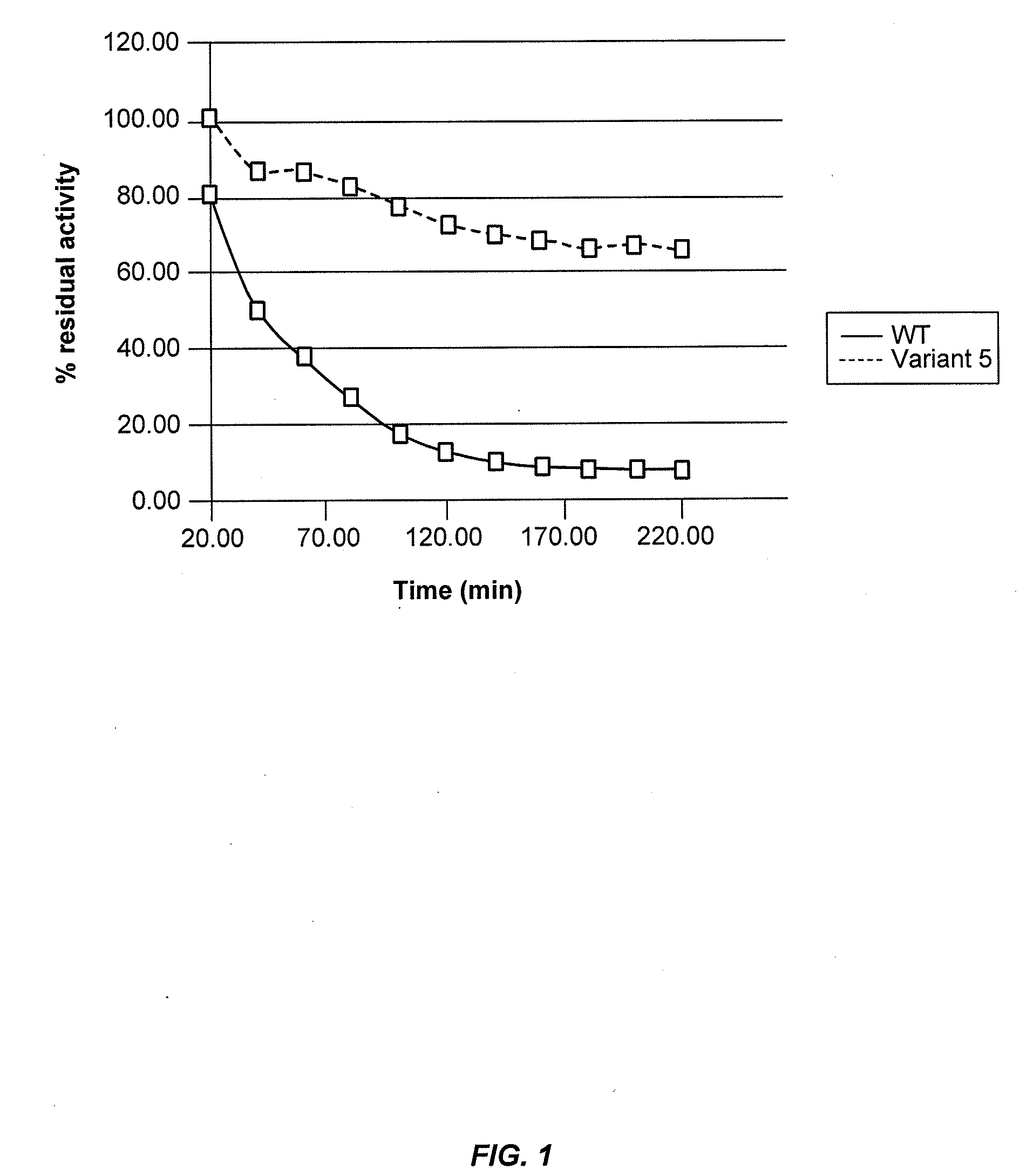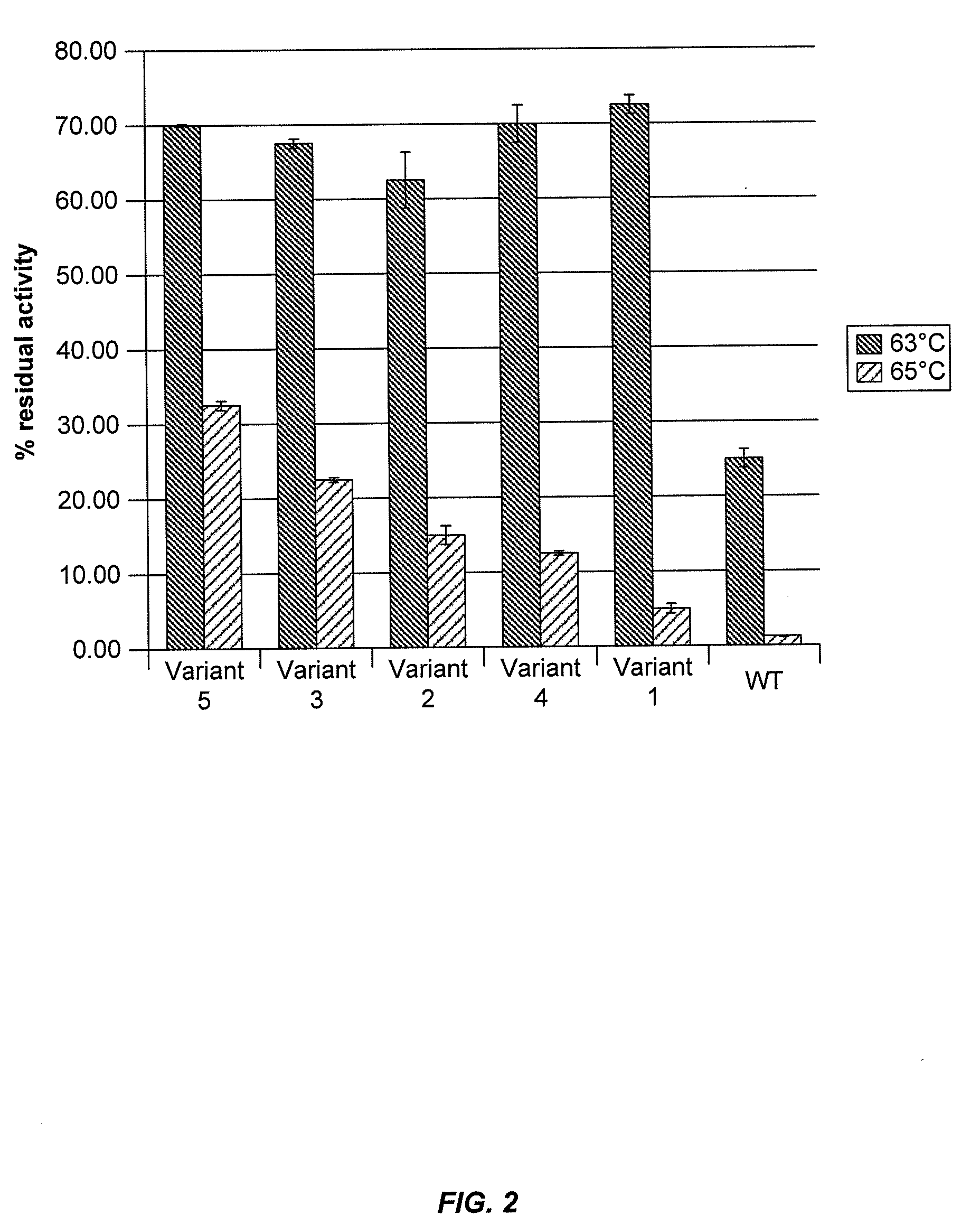Cellobiohydrolase variants
- Summary
- Abstract
- Description
- Claims
- Application Information
AI Technical Summary
Benefits of technology
Problems solved by technology
Method used
Image
Examples
example 1
Wild-Type C1 Cbh1a Gene Acquisition and Construction of Expression Vector
[0282]cDNA coding the secreted wild-type C1 CBH1a protein (SEQ ID NO:2) was amplified from a cDNA library prepared by Symbio, Inc. (Menlo Park, Calif.). Expression constructs were prepared in which the Cbh1a WT sequence was linked to a native signal peptide for secretion in S. cerevisiae. The signal peptide sequence was PCR amplified with cDNA from the cDNA library. C1 Cbh1a cDNA construct was cloned into a pYTDX20 shuttle vector (i.e., pBS24Ub modified so that transcription is under the control of a C1 chitinase (chi) promoter).
[0283]S. cerevisiae cells were transformed with the expression vector. Clones with correct Cbh1a sequences were identified and activity was confirmed using a MUL assay (4-methylumbelliferyl β-D-lactopyranoside; see Example 3, infra).
example 2
Production of C1 CBH1a—Shake Flask Procedure
[0284]A single colony of S. cerevisiae containing a plasmid with the C1 Cbh1a gene was inoculated into 3 ml of synthetic media containing 60 g / L glucose, 6.7 g / L yeast nitrogen base, 5 g / L ammonium sulfate, and 2 g / L amino acid drop-out mix minus uracil (D9535, United States Biological, Swampscott, Mass.). Cells were grown overnight (at least 16 hours) in an incubator at 30° C. with shaking at 250 rpm. 0.7 ml of this culture was diluted into 50 ml of synthetic defined expression medium containing 20 g / L glucose, 6.7 g / L yeast nitrogen base without amino acids (Y0626, Sigma, St. Louis, Mo.), 5 g / L ammonium sulfate, 10 g / L potassium phosphate (monobasic), 10 g / L galactose, 24 g / L amino acid drop-out mix minus uracil (D9535, United States Biological), 3.6 ml TIPC solution (0.05 g / L thiamine, 0.1 g / L myo-inositol, 0.05 g / L calcium pantotenate and 1 g / L choline chloride) and 0.2 ml vitamin solution (1.5 g / L pyridoxine, 1 g / L P-amino butyric aci...
example 3
Assays to Determine Cellobiohydrolase Thermoactivity and Thermostability
[0285]Cellobiohydrolase thermoactivity may be determined using a 4-methylumbelliferyl β-D-lactopyranoside (MUL) assay or by measuring cellobiohydrolase activity on biomass substrate. Cellobiohydrolase thermostability may be determined by exposing the cellobiohydrolase to stress conditions of elevated temperature and / or low pH for an appropriate period of time and then determining residual cellobiohydrolase activity by a MUL assay or a cellulose assay.
4-Methylumbelliferyl β-D-lactopyranoside (MUL) Assay
[0286]In a total volume of 75 μl, 50 μl of 0.6 mM 4-methylumbelliferyl β-D-lactopyranoside (MUL) in 250 mM sodium acetate, pH 4.4 was added to 25 μl of S. cerevisiae supernatant containing secreted C1 CBH1a protein. The reaction was incubated for 60 minutes at 63° C., then centrifuged briefly and 50 μl was transferred to 150 μl of 1 M Na2CO3 pH 10.5 in a flat-bottom black plate to terminate the reaction. The amount...
PUM
| Property | Measurement | Unit |
|---|---|---|
| Fraction | aaaaa | aaaaa |
| Fraction | aaaaa | aaaaa |
| Volume | aaaaa | aaaaa |
Abstract
Description
Claims
Application Information
 Login to View More
Login to View More - R&D
- Intellectual Property
- Life Sciences
- Materials
- Tech Scout
- Unparalleled Data Quality
- Higher Quality Content
- 60% Fewer Hallucinations
Browse by: Latest US Patents, China's latest patents, Technical Efficacy Thesaurus, Application Domain, Technology Topic, Popular Technical Reports.
© 2025 PatSnap. All rights reserved.Legal|Privacy policy|Modern Slavery Act Transparency Statement|Sitemap|About US| Contact US: help@patsnap.com



